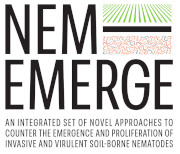
A model to simulate nematode population densities and genetic frequencies under different control strategies
A group of researchers from NEM-EMERGE partner INRAE recently published an article in the journal Evolutionary Applications. The study was started before the launch of NEM-EMERGE but was completed as part of the project.
In this research, scientists simulated the evolution of one of the most common potato-cyst nematodes, Globodera pallida, by combining three strategies against them, namely masculinization resistance, rotation and biocontrol, since the most effective chemical nematicides used for decades have been banned over the past decade. The model showed that this combination could lead to sustainable suppression of G. pallida within a reasonable timeframe.
Rotation consists of growing non-potato crops instead of potatoes every year, as G. pallida cannot reproduce in the absence of potatoes. However, eggs can survive within cysts for years in the absence of a host, so the effectiveness of crop rotation is limited. A complementary method could be the use of trap crops, i.e. non-host crops that induce egg hatching. Larvae hatching from eggs do not survive more than 2 weeks without a host.
Biocontrol includes the use of natural enemies such as fungi that produce nematicide compounds, colonise plant roots or parasitise nematode eggs. However, using living organisms is much more difficult than using a molecule because of the complexity of ecological interactions in the field.
Resistance means breeding genetically resistant varieties, which can be very effective in controlling G. pallida. There are two types of resistance to G. pallida: blocking resistance and masculinising resistance. Blocking resistance occurs when the nematode larvae are unable to complete their developmental cycle on the host.
Masculinising resistance occurs when G. pallida larvae can infect the host but cannot exploit it well enough to produce females. Sexual differentiation in these nematodes is dynamic and density dependent. Females are all virulent and die filled with eggs, becoming a hardened structure, the cyst, capable of surviving harsh soil conditions. Meanwhile, males, can be virulent or avirulent, depending on their genetic variants and the host plant. In the case of the potato‐resistant cultivars used in Europe (all coming from Solanum vernei) virulence is recessive. This means that male nematodes must have both virulent alleles of the virulence-related gene to be virulent to this plant, as they are diploid, carrying two complete sets of chromosomes, like humans, and the gene is diallelic, meaning that it has two variants, being in this case one virulent and the other one avirulent.
Carrying out experiments to test all possible combinations over multiple years would be long and costly. INRAE researchers therefore used mathematical modelling to simulate the dynamics of the disease over several years and compare control strategies.
The study provides insight into the interplay between masculinising resistance and nematode demography (nematode population densities and genetic frequencies). A key finding is that although masculinising resistance alone does not guarantee nematode suppression, it plays a crucial role in reducing nematode populations. Overall, our research highlights the potential of an integrated approach combining masculinising resistance with biocontrol and crop rotation for effective long-term control of G. pallida.
Share on Facebook Share on Twitter Share on Pinterest